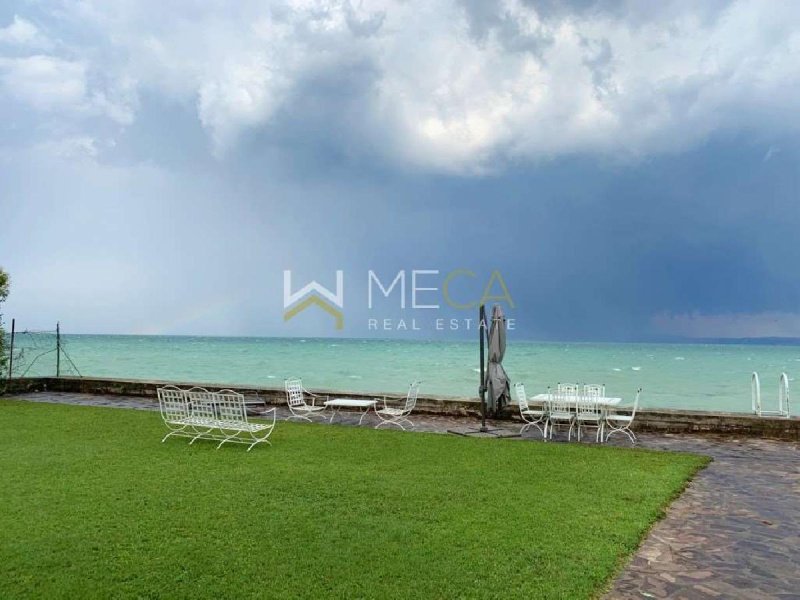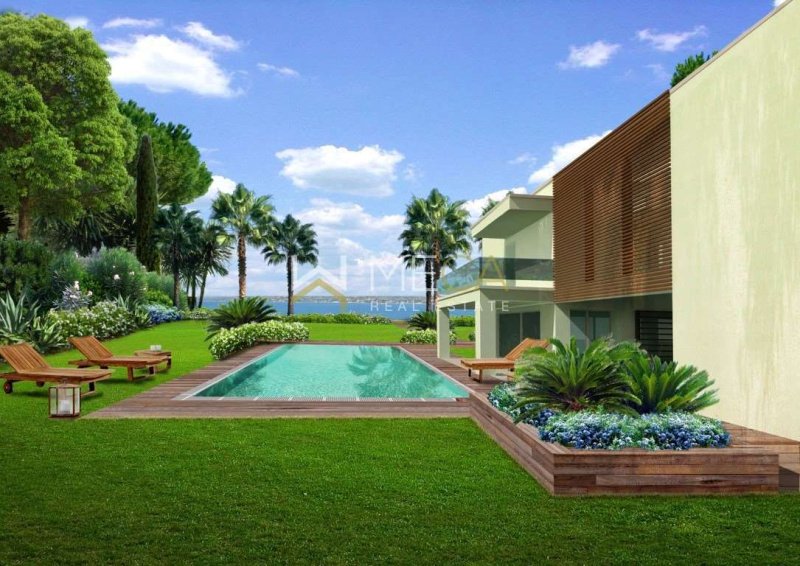Sirmione, on the peninsula, about 1 km from the castle and the historic center, villa built in the 1970s with a garden directly on the lake.
The plot on which the villa is built measures approximately 2,000 square meters, the villa is on two levels for a total of over 300 commercial square meters.
Lower floor with garage for 3 cars, bathroom and two rooms;
Upper floor with dining room and kitchen, both with access to a terrace overlooking the lake, two bathrooms, double bedrooms and a single bedroom.
It is possible to buy it completely renovated as per existing project already approved, of which you can see the renderings in this announcement.
The displayed price refers to the villa in its current state of fact.
Monuments and places of interest
Scaliger Castle: The Scaliger Castle is a fortress guarding the only southern access point to the historic center, built by the Scaligers, from which it took its name, during the 13th and 14th centuries and in two phases: the first under Mastino I and the last one under Cangrande I. Surrounded by the waters of Lake Garda, it is defended by three towers and by the keep, forty-seven meters high. To the east of the castle is the fortified dock for the fleet's refuge. The battlements of the fortress are dovetailed, while those of the dock are spearheaded. Church of Sant'Anna: It is a small ecclesial building that stands near the Scaligero castle. Dedicated to the mother of the Madonna, it was built in the fifteenth century to serve the Venetian garrison placed to defend the fortress. Inside there are votive frescoes from the sixteenth century, a stone painting depicting the Madonna and a Scaligeri coat of arms. Church of Santa Maria della Neve: The church of Santa Maria della Neve, also known as Santa Maria Maggiore, is the parish church of Sirmione. It was built in the fifteenth century on top of the remains of the church of San Martino in Castro from which part of the material used in the construction comes. The northern facade rests on the ancient wall that surrounded the town. The entrance facade is decorated in terracotta and is characterized by a five-arched portico, originally part of the cemetery as evidenced by some tombs placed on its floor. A milestone dedicated to the third consular year of Emperor Julian the Apostate was reused for a column in the portico. The interior has a single nave and has five altars. The votive frescoes are from the fifteenth century as well as the wooden statue representing a "Madonna enthroned" from the same period. The crucifix is from the sixteenth century and is attributed to Domenico Brusasorzi. The organ dates back to the eighteenth century. Church of San Pietro in Mavino: The church of San Pietro in Mavino, dedicated to the apostle Peter, is already built according to an eighth-century document. It is located on the highest point of the peninsula and probably takes its name from the Latin summa vinea, meaning vineyard located on the top, from which Mavino. The original building, in Romanesque style, was rebuilt and raised around 1320. The bell tower was erected in 1070 maintaining the same style of the church. Inside, the frescoes in the three apses date back to the twelfth century, while those on the walls are from the sixteenth century.
自动翻译所用的语言
Sirmione, in penisola a circa 1 km dal castello e dal centro storico, villa edificata negli anni 1970 con giardino direttamente a lago.
Il lotto sul quale la villa è costruita misura 2.000 mq circa, la villa è disposta su due livelli per un totale di oltre 300 mq commerciali.
Piano inferiore con box auto per 3 auto, bagno e due stanze;
Piano superiore con sala da pranzo e cucina abitabile, entrambe con accesso a terrazza vista lago, due bagni, de camere matrimoniali e camera singola.
E' possibile acquistarla totalmente ristrutturata come da progetto esistente già approvato, del quale si possono vedere i render nel presente annuncio.
Il prezzo esposto è relativo alla villa nello stato di fatto attuale.
Monumenti e luoghi d'interesse
Castello scaligero : Il castello scaligero è una rocca a guardia dell'unico punto d'accesso meridionale al centro storico.Fu costruita dagli Scaligeri, da cui prese il nome, durante il XIII e il XIV secolo e in due fasi: la prima sotto Mastino I e l'ultima sotto Cangrande I.Circondato dalle acque del lago di Garda, è difeso da tre torri e dal maschio, alto quarantasette metri. Ad oriente del castello è presente la darsena fortificata per il rifugio della flotta. Le merlature della rocca sono a coda di rondine, mentre quelle della darsena sono a punta di lancia. Chiesa di Sant'Anna : È un piccolo edificio ecclesiale che sorge nei pressi del castello scaligero. Dedicata alla madre della Madonna, fu costruita nel Quattrocento al servizio della guarnigione veneta posta a difesa della rocca.All'interno sono presenti affreschi votivi del Cinquecento, un dipinto su pietra raffigurante la Madonna e uno stemma degli Scaligeri. Chiesa di Santa Maria della Neve: La chiesa di Santa Maria della Neve, detta anche Santa Maria Maggiore, è la parrocchiale di Sirmione. Fu edificata nel Quattrocento sopra i resti della chiesa di San Martino in castro dalla quale proviene parte del materiale utilizzato nella costruzione.La facciata settentrionale poggia sull'antico muro che cingeva la cittadina. La facciata d'ingresso è decorata in terracotta ed è caratterizzata da un portico a cinque arcate, in origine facente parte del cimitero come dimostrano alcune tombe poste sul pavimento dello stesso. Per una colonna del porticato è stata riutilizzata una pietra miliare dedicata al terzo anno consolare dell'imperatore Giuliano l'Apostata.L'interno è a un'unica navata e presenta cinque altari. Gli affreschi votivi sono del Quattrocento come dello stesso periodo è la statua lignea che rappresenta una “Madonna in trono”. Il crocifisso è del Cinquecento ed è attribuito a Domenico Brusasorzi. L'organo risale al Settecento.Chiesa di San Pietro in Mavino : La chiesa di San Pietro in Mavino, dedicata all'apostolo Pietro, secondo un documento dell'VIII secolo risulta già edificata.. Si trova sul punto più alto della penisola e probabilmente prende il nome dal latino summa vinea, ovvero vigna collocata sulla sommità, da cui Mavino.L'edificio originale, in stile romanico, fu ricostruito e sopraelevato attorno al 1320. Il campanile fu eretto nel 1070 mantenendo lo stesso stile della chiesa. All'interno gli affreschi delle tre absidi risalgono al XII secolo, mentre quelli alle pareti sono del Cinquecento.
CLASSE ENERGETICA: G
Sirmione, auf der Halbinsel, ca. 1 km vom Schloss und dem historischen Zentrum entfernt, in den 1970er Jahren erbaute Villa mit Garten direkt am See.
Das Grundstück, auf dem die Villa gebaut wird, misst ungefähr 2.000 Quadratmeter, die Villa erstreckt sich über zwei Ebenen und bietet insgesamt über 300 Gewerbefläche.
Untergeschoss mit Garage für 3 Autos, Bad und zwei Zimmern;
Obergeschoss mit Esszimmer und Küche, beide mit Zugang zu einer Terrasse mit Seeblick, zwei Badezimmer, Doppelzimmer und ein Einzelzimmer.
Es ist möglich, es komplett renoviert zu kaufen, gemäß einem bereits genehmigten bestehenden Projekt, von dem Sie die Renderings in dieser Ankündigung sehen können.
Der angezeigte Preis bezieht sich auf die Villa im aktuellen Zustand.
Denkmäler und Sehenswürdigkeiten
Scaligerburg: Die Scaligerburg ist eine Festung, die den einzigen südlichen Zugangspunkt zum historischen Zentrum bewacht, die von den Scaligern, von denen sie ihren Namen erhielt, im 13. und 14. Jahrhundert und in zwei Phasen erbaut wurde: die erste unter Mastino I und die letzter unter Cangrande I. Umgeben vom Wasser des Gardasees wird es von drei Türmen und einem 47 Meter hohen Bergfried verteidigt. Östlich des Schlosses befindet sich das befestigte Dock als Zufluchtsort für die Flotte. Die Zinnen der Festung sind mit Schwalbenschwänzen versehen, während die des Docks mit Speerspitzen versehen sind. Kirche Sant'Anna: Es ist ein kleines kirchliches Gebäude, das in der Nähe der Scaligerburg steht. Der Mutter der Madonna gewidmet, wurde es im 15. Jahrhundert erbaut, um der venezianischen Garnison zu dienen, die zur Verteidigung der Festung eingesetzt wurde. Im Inneren befinden sich Votivfresken aus dem 16. Jahrhundert, ein Steingemälde mit der Darstellung der Madonna und ein Wappen der Scaliger. Kirche Santa Maria della Neve: Die Kirche Santa Maria della Neve, auch Santa Maria Maggiore genannt, ist die Pfarrkirche von Sirmione. Sie wurde im 15. Jahrhundert auf den Überresten der Kirche San Martino in Castro errichtet, aus der ein Teil des für den Bau verwendeten Materials stammt. Die Nordfassade ruht auf der alten Mauer, die die Stadt umgab. Die Eingangsfassade ist mit Terrakotta verziert und zeichnet sich durch einen Portikus mit fünf Bögen aus, der ursprünglich Teil des Friedhofs war, wie einige Gräber auf seinem Boden bezeugen. Ein Meilenstein, der dem dritten konsularischen Jahr von Kaiser Julian dem Abtrünnigen gewidmet war, wurde für eine Säule im Portikus wiederverwendet. Der Innenraum ist einschiffig und hat fünf Altäre. Die Votivfresken stammen aus dem 15. Jahrhundert, ebenso die Holzstatue einer „thronenden Madonna“ aus derselben Zeit. Das Kruzifix stammt aus dem sechzehnten Jahrhundert und wird Domenico Brusasorzi zugeschrieben. Die Orgel stammt aus dem achtzehnten Jahrhundert. Kirche San Pietro in Mavino: Die dem Apostel Petrus geweihte Kirche San Pietro in Mavino wurde bereits nach einem Dokument aus dem 8. Jahrhundert erbaut. Es befindet sich auf dem höchsten Punkt der Halbinsel und hat seinen Namen wahrscheinlich vom lateinischen summa vinea, was auf der Spitze gelegener Weinberg bedeutet, von dem Mavino stammt. Das ursprüngliche Gebäude im romanischen Stil wurde um 1320 umgebaut und erhöht. Der Glockenturm wurde 1070 unter Beibehaltung des gleichen Stils wie die Kirche errichtet. Im Inneren stammen die Fresken in den drei Apsiden aus dem 12. Jahrhundert, die an den Wänden aus dem 16. Jahrhundert.


